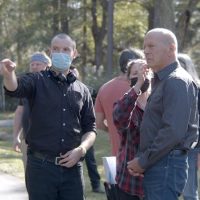 Filmmaker and producer Yu-Hsiu Camille Chen embarked on a journey to shoot her first feature film on the RED camera with the help of a dedicated team. Independent filmmaking has come so far with falling production costs and visual splendour from 2k and 4k HD workflows. Camille s determination to get the right balance to create her first film shows her ability to bring people together who share a common goal in storytelling.
Filmmaker and producer Yu-Hsiu Camille Chen embarked on a journey to shoot her first feature film on the RED camera with the help of a dedicated team. Independent filmmaking has come so far with falling production costs and visual splendour from 2k and 4k HD workflows. Camille s determination to get the right balance to create her first film shows her ability to bring people together who share a common goal in storytelling.
Little Sparrows depicts the story about a mother's unending love for her children and the choices she and her family must make when confronted by her discovery of breast cancer.
Shooting on the Red Camera
See how an independent filmmaker undertakes the mammoth task of directing their first feature.
Interview with Camille Chen
Iain: How did you get your first feature funded in Australia?
Camille: Little Sparrows was funded by Bolderpictures, which is a company that I and Peter Thomas, my partner and Executive Producer, established in 2008. In other words, we funded the making of the film ourselves without any additional funding including the popular source of government funding in Australia.
Iain: Were you able to get development financing for your script before you shot?
Camille: Again, no additional development financing from outside sources other than our company.
Iain: How did you bring the crew together for your movie?
Camille: Passion, persuasion, momentum and patience!
I am a firm believer in the quality of crew support. Due to the low-budget nature of the project, I knew that we had to keep the crew small and tight - close-knit, multi-tasking and sharing a lot of trust and passion for the project.
On any given shot day, we had around 10 crew members. This allowed us to move quickly from one location to next.
Some of the crew members worked with me on Conscience (short film, 2009). Eva Di Blasio (co-producer of the film) was the casting manager then and has played a larger role in this movie project. A lot of time and effort was invested in interviewing crew, explaining the nature of the project and getting to know each other. If you want to go for a long battle, and possibly be destroyed by it, better do it with people with who have ability but also the heart.
The crew was a combination of professionals and fresh graduates. I wanted professional or more senior crew members to be able to mentor younger members of the team. This worked really well during the shoot. One of the things we did during pre-production other than a series of meetings, was to organise a bowling event. Forget about the movie and let s have fun! It was a great event to bring cast and crew together, breaking the ice, so to speak.
Iain: What was the casting process like and were there hurdles you had to overcome?
Camille: Casting is one of the most exciting directing processes before landing on set. Some of the casting choices came naturally and instinctively. Some, more difficult to find. Most of the parts were written with the actors in mind, so persuading the actors to be involved was more of the challenge.
The most important and difficult casting choice was for the part of the mother, Susan, the matriarch of the story. Many seasoned actresses were recommended for the role. Some with the right look. Some with impressive credentials. Somehow, no one really fitted the bill, until the name of Nicola Bartlett was brought up, less than a month leading to the shoot.
Nicola came for a casual audition, a chat. The moment I saw her, I said to you, you are beautiful. Her grace and presence impressed me immediately. As I started to explain the project, the characters, Nicola s eyes lit up. She said, you got to be joking, you are describing the story of my life. This is too unreal.
The parallel of the character of Susan and the personal journey of Nicola, being a mother to three daughters surviving life s ups and downs, is so close that instantly both she and I realised that we had something very special here. She IS Susan and she will bring insights to the characterisation beyond the written words.
Iain: Can you tell us about your experience working with the RED camera and how it helped you achieve your visual goals?
Camille: Little Sparrows is the second project that I have worked with the RED ONE camera. Previously, my short film, Conscience, was also photographed on this particular digital format.
First of all, I am a fan. The HD format is extremely dynamic, the result is brilliant and it is so cost-effective compared to traditional film stock. However, being a digital camera, it does have its sweet spots. The key is quality lenses and the right blend of natural and artificial lighting. With Little Sparrows, Jason Thomas (DOP) and I insisted on using Ultra Prime Lenses. And it was definitely the best choice we could have made.
The HD format also allowed me to shoot under some low-light situations and move from location to location very quickly. This is extremely important as I worked so intimately with the actors and I was able to rewrite the scenes and change the direction based on the actual conditions on the set. It gave me enormous comfort and freedom.
The other key choice in cinematographic style was the use of hand-held camera. Again, for speed and efficiency. However, the way Jason operated the camera is far from the dry dogma style, on the contrary, the camera was so intuitively connected with the drama and the characters, it was fluid and most of the time seemingly invisible. Jason's camera became part of the emotional terrain of the story, poetic and candid.
Some of the most important and emotional scenes of the film were shot on dual cameras, and more so on long takes, up to 30 minutes. This was a directing style I adopted to allow actors to move freely within the space and explore the dramatic tension given in the situation. And this stylistic choice wouldn't be possible with a film format, but accessible with HD.
Iain: What were the editing and colour correction techniques that your editor used?
Camille: FiL Baker, the editor worked with me on Little Sparrows, and is a brilliant storyteller. We had a lot of footage (remembering those long takes) and we needed to give the story and the performance a deeper and stronger sense of focus and cohesion it needed. And we achieved so by being absolutely brutal with the materials. I can honestly say that some of my favourite shots, for the sake of its visual power and significance, never made it to the cut.
The RED post workflow is flexible and there is no fixed path. Some find it confusing. I think it is all about management of the files and understanding the process.
We cut with low res proxy Quicktime movie files on Final Cut Pro. It was very straight-forward. As soon as we locked the picture edit, we exported the EDL and continued on-line conforming in Smoke, which can be a lengthy process for data rendering.
The colour grading was done in Smoke. I worked with Steve Vojkovic at BoogieMonster. Steve is a highly regarded visual effects artist and recently returned to his hometown, Perth in Western Australia, after working on some high-profile blockbusters (including King Kong) in LA. The possibility of grading is virtually inexhaustible. What Steve and I tried to achieve was to give the film texture and richness (with striking palette, the red, blue, green) and yet still maintain a prevailing sense of reality.
Little Sparrows allows the audience to experience the daily life on screen through the prism of refinement and beauty.
Iain: Can you share with us your collaboration with a composer and how it came about?
Camille: I have known Keith van Geyzel and Tim Count (Music Design System, MDS) for several years through a mutual filmmaker friend. Little Sparrows is the third project and first feature drama film that we have collaborated on.
Previously, Keith and Tim scored for Conscience (short film, 2009) and Metal for our time a corporate presentation that I directed and produced in 2008.My brief with Keith and Tim is often brief. I like to keep it simple and straight forward. And I knew I could afford to do so trusting and knowing the experiences and sensitivities of the dual.
With Conscience, I wanted music that's both haunting and poetic. The soundtrack was a curious combination of lyrical piano and striking sound design. With Little Sparrows, I wanted to step even further forward. I invited both Keith and Tim to feel and understand my vision and my voice in the film, and be inspired. I wanted the music to be the key in linking the characters and their sentiments, without being mawkish and indulgent.
I didn't want to dictate to my composers the choice of instruments and composition. Instead, we talked about the stories and the richness of the characters. What I truly admire Keith and Tim is that their music could easily stand on its own but never become intrusive with the performance and story. And that, in my opinion, comes from the restraint and maturity of true professional.
The result is undoubtedly beautiful and powerful to listen to and feel as how music should be.
To find out more about the cast and crew visit :
Fan page : http://www.facebook.com/pages/Little-Sparrows-the-Movie/376437078210?v=wall





















